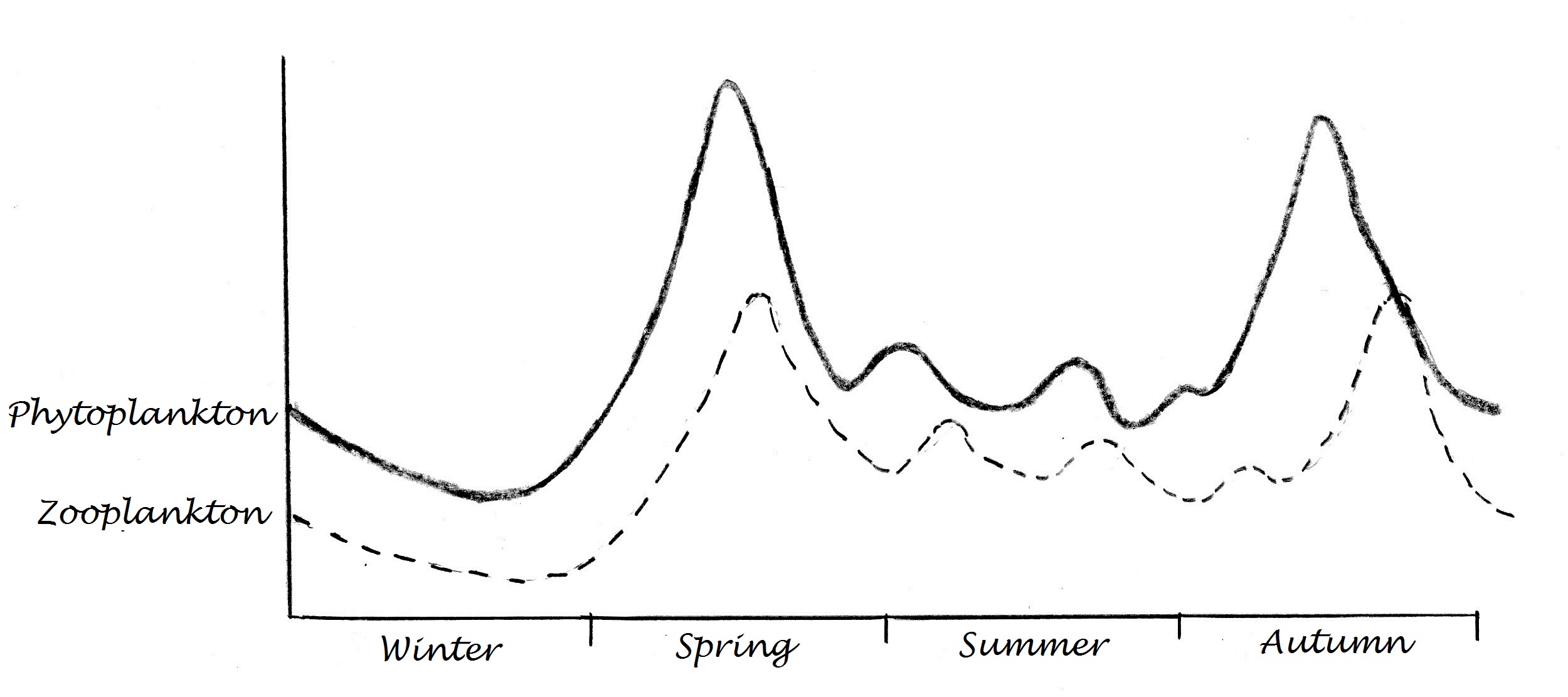Question
- Leaving Cert. Biology (Higher) 2014: Q15
- Back to the question >
Answer
(a)
(i) The population’s levels are highest in spring and autumn when there are plenty of nutrients, light and a suitable temperature.
(ii) The nutrient levels are high in winter as there are not so many plants growing due to the lower temperature and lack of light.
(iii) Phosphates
(iv)

The graph for the zooplankton lags behind the phytoplankton, as the zooplankton eats the phytoplankton the numbers are always less. The rises and falls of the graph are similar. As the numbers of phytoplankton increase, there is more food for the zooplankton so their numbers increase but then as the numbers drop so do the zooplankton.
(v) It drops in late autumn because the temperature and light are both dropping.
(b)
(i) Capture/ recapture method:
Set a number of humane traps for rabbits that will not harm the rabbits in any way. Mark the rabbits caught in some way (but not in a way that will harm the rabbit or make it more visible to predators). Count the number of rabbits marked and release them into the wild. Reset the traps. Count how many rabbits are trapped and of the trapped rabbits how many have marks; release the rabbits again. Calculate the number of rabbits in the area as follows:

(ii) There is an abundance of food and no predators.
(iii) The animals that fed on that plant will also die out and other plants that competed with that species may flourish.
(iv)
Advantage:
You can target the exact species you wish.
Disadvantage:
The results may be short lived. If not all the species are affected you may have a very resilient population left.
(v) A lot, though not all, of the rabbits were killed; this means that those left have very little competition and so can multiply rapidly.
(c)
(i) Disease, war and famine
(ii) Reasons for rapid population increase:
(iii) As the human population continues to increase, using up ever more finite resources and producing more waste, there is a great danger that biodiversity will be seriously reduced.
(iv) Reduce, reuse and recycle
(v) Pollution is any undesirable change in the environment.
(vi) Micro-organisms are used in waste management to degrade organic material in landfill sites. Micro-organisms are specifically cultivated in waste water treatment plants to break down sewage and other waste water.
(vii)
Nitrogen Cycle
Carbon Cycle
(i) The population’s levels are highest in spring and autumn when there are plenty of nutrients, light and a suitable temperature.
(ii) The nutrient levels are high in winter as there are not so many plants growing due to the lower temperature and lack of light.
(iii) Phosphates
(iv)

The graph for the zooplankton lags behind the phytoplankton, as the zooplankton eats the phytoplankton the numbers are always less. The rises and falls of the graph are similar. As the numbers of phytoplankton increase, there is more food for the zooplankton so their numbers increase but then as the numbers drop so do the zooplankton.
(v) It drops in late autumn because the temperature and light are both dropping.
(b)
(i) Capture/ recapture method:
Set a number of humane traps for rabbits that will not harm the rabbits in any way. Mark the rabbits caught in some way (but not in a way that will harm the rabbit or make it more visible to predators). Count the number of rabbits marked and release them into the wild. Reset the traps. Count how many rabbits are trapped and of the trapped rabbits how many have marks; release the rabbits again. Calculate the number of rabbits in the area as follows:
(ii) There is an abundance of food and no predators.
(iii) The animals that fed on that plant will also die out and other plants that competed with that species may flourish.
(iv)
Advantage:
You can target the exact species you wish.
Disadvantage:
The results may be short lived. If not all the species are affected you may have a very resilient population left.
(v) A lot, though not all, of the rabbits were killed; this means that those left have very little competition and so can multiply rapidly.
(c)
(i) Disease, war and famine
(ii) Reasons for rapid population increase:
- The industrial and agricultural revolutions led to better nutrition, which increased life expectancy.
- There was a decreased death rate due to better medicine and vaccinations.
(iii) As the human population continues to increase, using up ever more finite resources and producing more waste, there is a great danger that biodiversity will be seriously reduced.
(iv) Reduce, reuse and recycle
(v) Pollution is any undesirable change in the environment.
(vi) Micro-organisms are used in waste management to degrade organic material in landfill sites. Micro-organisms are specifically cultivated in waste water treatment plants to break down sewage and other waste water.
(vii)
Nitrogen Cycle
- Plants absorb nitrates from the soil and use the nitrogen to form proteins.
- Animals eat the plants and use the nitrogen to form animal proteins.
Carbon Cycle
- Plants remove carbon dioxide from the atmosphere in photosynthesis and return it in respiration.
- Animals obtain carbon by eating plants and release it in respiration.
